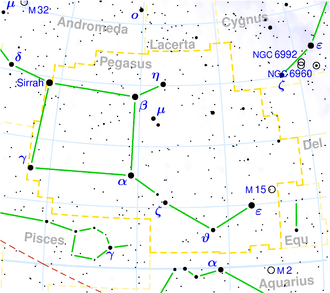IC 1473
| Galaxie IC 1473 | |
|---|---|
 | |
| SDSS-Aufnahme | |
| AladinLite | |
| Sternbild | Pegasus |
| Position Äquinoktium: J2000.0, Epoche: J2000.0 | |
| Rektaszension | 23h 11m 50,4s[1] |
| Deklination | +29° 38′ 36″[1] |
| Erscheinungsbild | |
| Morphologischer Typ | S0[1] |
| Helligkeit (visuell) | 12,9 mag[2] |
| Helligkeit (B-Band) | 13,9 mag[2] |
| Winkelausdehnung | 2,1′ × 1′[2] |
| Positionswinkel | 176°[2] |
| Flächenhelligkeit | 13,6 mag/arcmin²[2] |
| Physikalische Daten | |
| Rotverschiebung | 0.002802 ±0.000023[1] |
| Radialgeschwindigkeit | 840 ±7 km/s[1] |
| Hubbledistanz vrad / H0 | (46 ± 3) · 106 Lj (14,2 ± 1,0) Mpc [1] |
| Geschichte | |
| Entdeckung | Truman Safford |
| Entdeckungsdatum | 1. Oktober 1866 |
| Katalogbezeichnungen | |
| IC 1473 • UGC 12404 • PGC 70633 • CGCG 496-052 • MCG +05-54-043 • 2MASX J23110486+2938164 • LDCE 1561 NED010 | |
IC 1473 ist eine linsenförmige Galaxie vom Hubble-Typ S0[2] im Sternbild Pegasus. Sie ist schätzungsweise 46 Millionen Lichtjahre von der Milchstraße entfernt.
Das Objekt wurde am 1. Oktober 1866 von dem Astronomen Truman Henry Safford entdeckt.[3]
Weblinks
Einzelnachweise
Auf dieser Seite verwendete Medien
Autor/Urheber: Sloan Digital Sky Survey, Lizenz: CC BY 4.0
The sky image is obtained by Sloan Digital Sky Survey, DR14 with SciServer.
Angle of view: 4' × 4' (0.3" per pixel), north is up.
Details on the image processing pipeline: https://www.sdss.org/dr14/imaging/jpg-images-on-skyserver/



